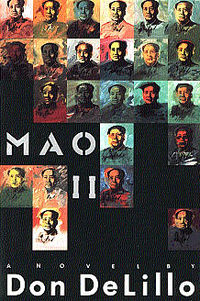- Mao II
-
Mao II 
Author(s) Don DeLillo Country United States Language English Genre(s) Novel Publisher Scribner Publication date 20 June 1991 Media type Print (Hardback & Paperback) Pages 256 (hardback first edition) ISBN 0-670-83904-3 OCLC Number 22766802 Dewey Decimal 813/.54 20 LC Classification PS3554.E4425 M36 1991 Mao II, published in 1991, is Don DeLillo's tenth novel. It was the winner of the PEN/Faulkner Award in 1992. The title is derived from a series of Andy Warhol silkscreen prints depicting Mao Zedong. This book was dedicated to DeLillo's editor, Gordon Lish.
Contents
Plot summary
A reclusive novelist named Bill Gray works endlessly on a novel he chooses not to finish. He has chosen a lifestyle completely secluded from life to try to keep writing pure. He, along with his assistant Scott, believe that something is lost once a mass audience reads the work. Scott would prefer Bill didn't publish the book for fear that the mass-production of the work will destroy the "real" Bill. Bill has a dalliance with Scott's partner Karen Janney, a former member of the Unification Church who is married to Kim Jo Pak in a Unification Church Blessing ceremony in the prologue of the book.
Bill, who lives as a complete recluse, accedes to be photographed by a New York photographer named Brita who is documenting writers. In dialogue with Brita and others, Bill laments that novelists are quickly becoming obsolete in an age where terrorism has supplanted art as the "raids on consciousness" that jolt and transform culture at large. Gray disappears without a word and secretly decides to accept an opportunity from Charles to travel to London to publicly speak on the behalf of a Swiss writer held hostage in war-torn Beirut.
Meanhile Karen ends up living in Brita's NY apartment and spends most of her time in the homeless slums of Tompkins Square Park. In London, Bill is introduced to George Haddad, a representative of the Maoist group responsible for kidnapping the writer. Bill decides to go to Lebanon himself and negotiate the release of the writer. Cutting himself off from Charles, he flees to Cyprus where he awaits a ship that will take him to Lebanon.
In Cyprus Bill is hit by a car and suffers a lacerated liver which, exacerbated by his heavy drinking, kills him in his sleep while en route to Beirut. In the epilogue/last chapter, Brita goes to Beirut to photograph Abu Rashid, the terrorist responsible for the kidnapping. The fate of the hostage is never revealed, though the implication is grim. The plot unfolds with DeLillo's customary shifts of time, setting, and character.
Main themes
The last sentence of the prologue reveals an important and major theme in Mao II: "The future belongs to crowds." Crowds feature heavily in the book, from the opening crowds of thousands at the mass-wedding at Yankee Stadium, to the crowds living in Tompkins Square Park, to the thousands of mourners at the Ayatollah's funeral as observed on television by Karen. The nature of crowds and their relation to personal and collective identity are explored.
In predicting an age of terror in which "the major work involves midair explosions and crumbled buildings," DeLillo was eerily ahead of his time in contemplating the profound effect that political terror was soon to have on American society. The question of the efficacy of art in the context of dogmatism and violence of a massive scale is central to the narrative. In preparing the novel, DeLillo's editor at Viking, Nan Graham said "Long before he had written anything Don told me he had two folders -- one marked 'art' and the other marked 'terror.'"[1]
Just two years before the novel was published Khomeini issued a fatwa calling for the death of Salman Rushdie after his publication of The Satanic Verses and New York Post photographers had ambushed J.D. Salinger in New Hampshire. DeLillo cited the published Salinger photograph and a photograph of a Unification Church Blessing ceremony he came across as inspiration for the book, telling Vince Passaro
“ I didn't know it at the time, but these two pictures would represent the polar extremes of "Mao II," the arch individualist and the mass mind, from the mind of the terrorist to the mind of the mass organization. In both cases, it's the death of the individual that has to be accomplished before their aims can be realized.[1] ” References
- ^ a b "Dangerous Don DeLillo", May 19, 1991 New York Times
External links
- New York Times review
- A Lecture on Mao II by Tom LeClair
Works by Don DeLillo Novels: Americana · End Zone · Great Jones Street · Ratner's Star · Players · Running Dog · Amazons · The Names · White Noise · Libra · Mao II · Underworld · The Body Artist · Cosmopolis · Pafko at the Wall · Falling Man · Point Omega
Plays: Screenplays: Categories:- 1991 novels
- Novels by Don DeLillo
- Postmodern novels
Wikimedia Foundation. 2010.
